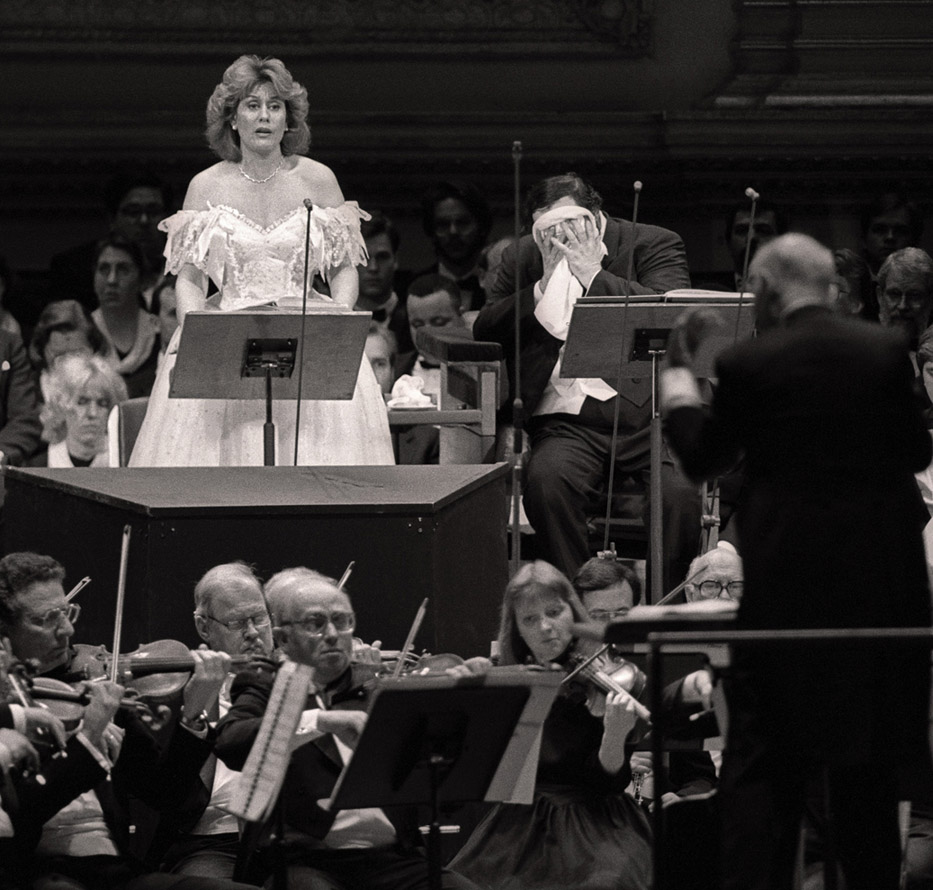by Sedgwick Clark
It’s time to say “no” to water bottles on the concert stage.
When did this unseemly swig become acceptable? It was said that Franco Corelli would wander offstage for refreshment between arias. (I do remember him unaccountably disappearing mid-scene a couple of times in the Met’s Macbeth 38 years ago, the only time I saw him live.) I’ve yet to see a singer whip out a Poland Spring or Evian at the Met, but I suppose it would be okay in a Gen X staging of West Side Story.
Obviously it began when plastic water bottles became a whole generation’s blue blanket. On occasion we used to see a glass of water placed under a presumably ailing soloist’s chair for a sip. But a plastic, labeled vessel looks tacky. City Arts music critic Jay Nordlinger took after one of the soloists in the New York Philharmonic’s recent Missa solemnis (“This is gross. It looks terrible. From time immemorial, singers managed without bottles of water at their feet, and on their lips. Today’s singers should discard this crutch-like and ugly habit.”) My wife always sees red when singers indulge themselves. “It’s a distraction for both the audience and fellow performers,” she insists. “They are leaning down to pick up the bottle, unscrewing the top, leaning their heads back to take a drink, screwing the top back on, and leaning down again to put it on the floor. No matter how discreet, they are calling attention to themselves and away from the music.”
The worst example within memory was at Carnegie Hall in April, 1991. Luciano Pavarotti was singing his first (and last) Otellos with Kiri Te Kanawa as Desdemona and the Chicago Symphony under Georg Solti. He had a cold. But he couldn’t cancel because a live recording was being made. He sat through much of the performance I heard, and next to him was a table of waters and what looked like bottles of
 (left to right) Kiri Te Kanawa (Desdemona) struggles to hold the stage in Verdi’s Otello while Luciano Pavarotti (Otello) steals the limelight with his shenanigans. Georg Solti leads the Chicago Symphony Orchestra on April 16, 1991. Photo: ©Steve J. Sherman; www.stevejsherman.com.
(left to right) Kiri Te Kanawa (Desdemona) struggles to hold the stage in Verdi’s Otello while Luciano Pavarotti (Otello) steals the limelight with his shenanigans. Georg Solti leads the Chicago Symphony Orchestra on April 16, 1991. Photo: ©Steve J. Sherman; www.stevejsherman.com.
medicines. Often when he wasn’t singing or drinking he draped a white towel over his face, leaning back in his chair, breathing heavily. Distracting? You bet. Especially when his poor Desdemona was singing her “Willow Song” and “Ave Maria.” Te Kanawa, who maintained her composure and singing throughout that appalling spectacle, deserved a “Trouper of the Year” award.
In the good old days there were people who nixed such artistic missteps. Who will take the lead in condemning this unbecoming nip—performers, impresarios, critics?
Curious P.R.
James Levine may have had to cancel his performances at Tanglewood this summer, but his programs remain. This Saturday night is one of his most thoughtful: Berg’s Three Pieces for Orchestra, Richard Strauss’s Four Last Songs, and Mahler’s Fourth Symphony, conducted by Juanjo Meno. Is it my imagination, or is the press department trying to hide the less popular Berg work? In all its e-mailed announcements the Strauss and Mahler works have been emblazoned in large, bold-faced display type, but the Berg is mentioned only in the body of the release. All p.r. people know that pressure-prone editors tend to glance only at the release headlines. While my MA Directory deadline has yet to make me that harried, I did wonder at first if the Berg had been dropped when I was preparing my portion of the MA Web site’s Annotated Calendar.